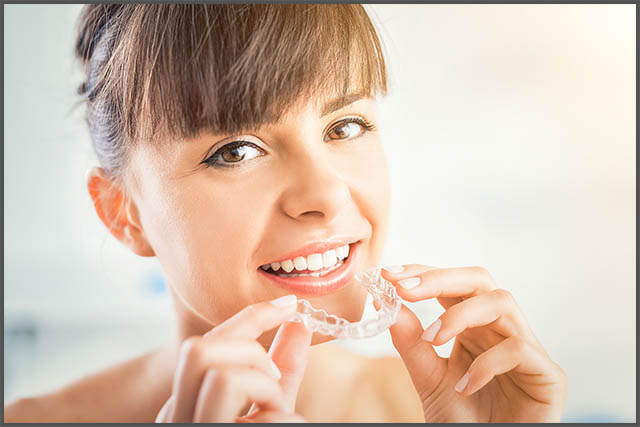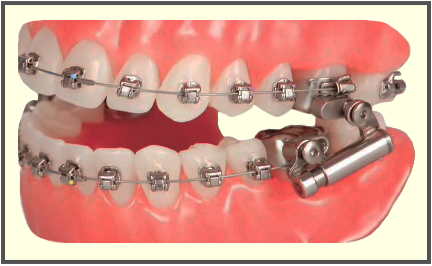Here Are Some Great FAQ’s To Help You & Your Family
When Should My Child See The Orthodontist?
By Donald W. Hunt, Jr., DMD, MSD, Hunt Orthodontics
 The American Association of Orthodontists recommends that all children should have a check-up with an orthodontic specialist no later than age 7. At an early age, an orthodontist can determine if a child has any developing jaw or dental problems as well as evaluating a child for airway obstruction. Orthodontic treatment also provides a significant increase in a child’s self confidence and social interaction.
The American Association of Orthodontists recommends that all children should have a check-up with an orthodontic specialist no later than age 7. At an early age, an orthodontist can determine if a child has any developing jaw or dental problems as well as evaluating a child for airway obstruction. Orthodontic treatment also provides a significant increase in a child’s self confidence and social interaction.
It has been proven through research that the old saying “wait till all the baby teeth come out” is not beneficial for all children. Some children, especially females, will begin their growth spurts prior to losing all of their baby teeth. Treatment may need to begin while a child is in their growth spurt.
 Parents can seek an orthodontic specialist’s opinion at anytime without a referral to answer their questions.
Parents can seek an orthodontic specialist’s opinion at anytime without a referral to answer their questions.
Individuals seeking early orthodontic screening will receive significant benefits from timely diagnosis and treatment of particular problems when appropriate. The value of early examination is a parent’s peace of mind knowing their child has been expertly evaluated.
The orthodontist’s goal is to provide individuals with the correct treatment at the proper time. By working together, the dental team can achieve exceptional results for your dental health and provide a lifetime of beautiful Smiles!
What Is An Orthodontist… And What Do They Do?
By Donald W. Hunt, Jr., DMD, MSD
 Orthodontists are uniquely qualified dental specialists who diagnose, prevent and treat dental, facial, and jaw irregularities to correctly align teeth and jaw relationships. While orthodontists primarily align teeth, they also influence jaw growth, and treat temporomandibular joint disorders “TMJ problems.”
Orthodontists are uniquely qualified dental specialists who diagnose, prevent and treat dental, facial, and jaw irregularities to correctly align teeth and jaw relationships. While orthodontists primarily align teeth, they also influence jaw growth, and treat temporomandibular joint disorders “TMJ problems.”
One of the primary goals of an orthodontist is to coordinate and correct a person’s “bite” to maintain proper tooth, periodontal, and TMJ health. Orthodontists also evaluate patients for potential airway issues and refer accordingly to Otolaryngologists (ENT’s) or Allergy physicians for proper care.
Orthodontists work in concert with your general dentist and other dental specialists such as periodontists, pedodontists, and oral surgeons to achieve exceptional results to increase a person’s dental health, self confidence, as well as their smile esthetics.
How do you become an Orthodontist?
First, one must complete a Bachelor’s of Science degree at a four year college and then be accepted into an American Dental Association (ADA) accredited College of Dental Medicine. After graduating from dental school four years later with a Doctorate in Dental Medicine or Dental Surgery (DMD or DDS), the general dentist has applied to an orthodontic specialty residency.
 Upon selection they then complete the required two to three years of additional specialized education in an accredited orthodontic residency program where they focus only on orthodontics. After completion of residency, the dentist is now an orthodontic specialist who is ready for private practice or research. The total process usually takes 10-11 years of training.
Upon selection they then complete the required two to three years of additional specialized education in an accredited orthodontic residency program where they focus only on orthodontics. After completion of residency, the dentist is now an orthodontic specialist who is ready for private practice or research. The total process usually takes 10-11 years of training.
A Lifetime of Continuing Education
Health care professionals strive to continue learning as new advancements from research presents for patient’s benefit. The American Association of Orthodontists (AOO) is a professional association of educationally qualified orthodontic specialists dedicated to ethically advancing the art and science of orthodontics, improving the health of the public, and promoting quality orthodontic care.
Ultimately, an orthodontist’s goal is to provide individuals with the proper treatment at the most appropriate time. Through continuing education and evaluation of credible research, patients benefit. By working together, the dental teams can achieve exceptional results for your dental health and provide you a lifetime of beautiful Smiles!
Achieving A Beautiful Smile
Donald W. Hunt, Jr. DMD, MSD
One of the first things people notice about one another is their smile. The whiteness and straightness of your teeth can influence the amount you smile and your overall confidence.
There are many benefits in seeking orthodontic treatment. The most obvious reason that someone seeks orthodontic treatment is to straighten their teeth to improve their smile. For others, the motivation may be from headaches and jaw joint (TMJ) problems. By coordinating the fit of the teeth, orthodontics can establish harmony between the teeth, jaw, TMJ’s, and the facial muscles. This helps alleviate chronic headaches and TMJ issues. Smile esthetics are optimized when the function is correct. Additionally, orthodontic treatment can idealize the dentition and space prior to restorative dental procedures such as needing implants to replace missing teeth.


Braces
 Braces are the tried and true method to straighten teeth. Braces are bonded to the teeth and adjustments are made by changing the tension on the archwires attached to the braces. Braces work because they are on the teeth constantly moving the teeth within the bone. Patients can choose the type of braces used while in orthodontic treatment. Small metal braces may still be the best option for children, adolescents, and the bottom teeth in adults for functional reasons. Children and teens have fun with the “Colors” used on braces. Advances in technology have made it possible for teens and adults to obtain treatment without having to worry how they will appear during treatment. Clear, ceramic or “tooth colored” braces are the best esthetic option for adults and those interested in a less noticeable appearance.
Braces are the tried and true method to straighten teeth. Braces are bonded to the teeth and adjustments are made by changing the tension on the archwires attached to the braces. Braces work because they are on the teeth constantly moving the teeth within the bone. Patients can choose the type of braces used while in orthodontic treatment. Small metal braces may still be the best option for children, adolescents, and the bottom teeth in adults for functional reasons. Children and teens have fun with the “Colors” used on braces. Advances in technology have made it possible for teens and adults to obtain treatment without having to worry how they will appear during treatment. Clear, ceramic or “tooth colored” braces are the best esthetic option for adults and those interested in a less noticeable appearance.
Clear Aligners
Another way to move teeth is through a series of removeable clear aligners with brand names like Invisalign, Clear Correct, Simpli 5 etc. Aligner treatment is comprised of a series of molded plastic trays that are worn over the teeth in a specific order. Each successive tray applies pressure to gently push the teeth closer to their optimal alignment. Each aligner is worn for usually 2-3 weeks per aligner before moving to the next. The patient has control of the aligner wear. Aligners are worn 22 hours a day to achieve the desired result.
Each type of orthodontic appliance has its own set of advantages and qualities.
For some patients, orthodontists may feel that braces will give them a better result than what clear aligners may be able to achieve. For others, clear aligners may achieve the result that they seek. Talk with your orthodontist to determine what is the best treatment for you.
The ultimate goal is for you to achieve your beautiful smile!
Accelerated Orthodontics
“When am I going to get my braces off?” Since the beginning of orthodontics, that has been the question orthodontists hear many times everyday in their practice. Of course the answer is different for every patient. Today, we live in an “instant gratification” society. That mindset has made it tougher on patients undergoing orthodontic treatment to be “patient.” Research has continually searched for ways to accelerate tooth movement.
The main limiting factor to tooth movement is the rate of bone growth and change. Bone growth takes 6 weeks to occur. That is why it takes months and years to move teeth. For over 60 years there have been surgical techniques to accelerate tooth movement. However, these treatments are invasive, have risk, and expense. Fortunately for patients today technology has made advances in noninvasive accelerated tooth movement with Acceledent. ™
Acceledent™ is a light, comfortable, hands free pulsatile delivery system with a mouthpiece that is used 20 minutes a day with braces or clear aligners (Invisalign™ Clear Correct ™) to accelerate tooth movement. Acceledent ™ came into the US market in 2012 with FDA approval after years of international testing. The patented pulsatile technology gently vibrates the teeth and surrounding bone, allowing the bone to change faster and thereby teeth move faster than “normal.” Acceledent ™ can be used for adolescents, teens, and adults. It is completely safe with no side effects.
Valid clinical research shows that teeth move anywhere from 38-50% faster than normal tooth movement with Acceledent. Adult bone is more dense than an adolescent’s. I explain to my adult patients to have expectations on the 38% end of decreased time while adolescents can expect more towards the 50% faster rate of treatment. Of course treatment times have many dependent factors such as compliance and complexity of the treatment.
In May of 2012 I started using Acceledent in my practice for my patients. I was very surprised with how much faster patients treatment times were decreased as well as their increased comfort during treatment. I also noticed that tooth movements were of a greater amount than I had seen before using Acceledent. Acceledent gives someone a predictable option to reduce their time in orthodontic treatment.
Orthodontists and patients now have a proven way to accelerate their orthodontic treatment to enjoy their new smile sooner than ever before!
Early Diagnosis of Airway Obstruction
Donald W. Hunt, Jr. DMD, MSD
Normal breathing occurs through the nose with our mouth closed. Nasal breathing is important because it is now known to be vital to good health. Research has shown that air breathed through the nose is quite different to the body than air breathed through the mouth.
Some infants, children, teens, and adults have airway obstruction. The obstruction can be in their nose, above their soft palate, or the back of the throat. Airway obstruction can be caused by enlarged adenoids, turbinates in the nose, tonsils, tongue, retruded upper and lower jaws, and obesity.
Airway obstruction contributes to developing teeth mal-alignment, bite, and jaw disharmonies. Chronic mouth breathing interferes with proper upper and lower arch development by disrupting tongue, cheek and lip muscle forces. Thereby causing a down and backward positioning of the lower jaw, a vertical long-faced growth pattern, and multiple abnormal growth patterns in the face, jaws, and dentition. Chronic mouth breathing has been shown to be 4 times more common in children with orthodontic abnormalities.
Airway obstruction can contribute to obstructive sleep apnea (OSA) and sleep disordered breathing which can cause lethargy upon waking in the morning or daytime tiredness. In the developing child, airway obstruction is correlated with narrow dental arches, crowding, overbites, and under-bites. Dark circles under the eyes, mouth breathing, dry chapped lips, snoring, and any cessation of breathing during sleep (apnea) are indicative of potential airway obstruction.
In adults, these same symptoms can be present and lead to varying degrees of obstructive sleep apnea. Severe OSA has a correlation to an increased risk of vascular complications such as arterial hypertension, coronary heart disease and stroke.
As an orthodontist, I refer children and adults to the otolaryngologist (ENT physician) for evaluation if I feel there is a potential airway obstruction issue contributing to the patient’s poorly developing dentition and jaw growth. Medical treatment modalities may involve simple topical steroid sprays such as Flonase, Nasonex, and Nasocort (to shrink the soft tissue in the nasal passages) up to surgical intervention such as removal of adenoids, tonsils, and turbinates.
Early diagnosis of airway obstruction and the malocclusion with the identification of the underlying causes, is essential to influence efforts to normalize craniofacial growth and development. Craniofacial jaw growth is 80-90% complete by age twelve years. Unfortunately, age twelve is still the average age that most orthodontic and facial orthopedic treatment starts for most children worldwide.
Early screening allows orthodontists to provide early orthodontic treatment such as upper jaw expansion that can reduce airway obstruction and craniofacial deformity, obligatory mouth breathing, and dental malocclusion.
Early orthodontic screening benefits children by allowing them to reach their full potential for healthy breathing and a lifetime of beautiful smiles!
Benefits of Space Maintainers for Children
Donald W. Hunt, Jr. DMD, MSD
Children may to missing teeth from genetic congenital absence, early loss of a tooth, or from extraction of a baby (primary) tooth due to dental decay. Whatever the reason, it is important to know the benefits of using a space maintainer and how it can help support your child’s future dental health and tooth alignment.
A space maintainer is an appliance that is custom-made by an orthodontist or dentist in acrylic or metal material. It can be either removable or cemented in a child’s mouth. Its purpose is to keep the space open to allow the permanent tooth to erupt and come into proper position. Baby teeth are the best “space maintainers” and they important to the development of the adult teeth, surrounding bone, and muscles. The baby teeth help to guide permanent teeth into position as the baby teeth are lost. If a space is not maintained, then the surrounding teeth can shift into the open space and then creating more involved future orthodontic treatment may be required. Not every child who loses a baby tooth early or to dental decay requires a space maintainer; however, a professional consultation with your orthodontist should be conducted to determine if a space maintainer is needed.
Types of Space Maintainers
There are two types of space maintainers for children: removable and fixed. Removable space maintainers are similar to orthodontic appliances and are usually made of acrylic or plastic. In some cases, an artificial tooth may be used to fill a space that must remain open for the adult tooth to erupt. There are many different kinds of fixed space maintainers that are cemented to the teeth. Some are unilateral while others are bilateral and attach to the molar teeth on either side of the dental arch.
Maintaining the Space Maintainer
Once the space maintainer is made by the orthodontist, it may take the child a few days to get accustomed to wearing the appliance whether it is removable or fixed. The orthodontist will review with the child and parent the proper ways to clean the space maintainer thoroughly in order to keep the gum tissue healthy and free of dental plaque.
If the space maintainer is fixed, it will be important to avoid chewy and sugary foods, and gum or candy, which may loosen or get caught on the appliance.
The child will be followed by the orthodontist on a regular basis to monitor the progress of treatment with the space maintainer and continue to receive a regular six-month professional cleaning appointment with your dental professional.
Space maintainers are beneficial to help avoid extraction of permanent teeth and to make future orthodontic treatment less involved.
Early orthodontic screening benefits children by allowing them to achieve a lifetime of beautiful and healthly smiles!
Wearing Retainers after Orthodontic Treatment is a Must!
Donald W. Hunt, Jr. DMD, MSD
Finally, you or your child is getting their braces removed or clear aligner treatment is finished. It’s been a journey to a beautiful smile and straight teeth. Just when you think the end is near, the orthodontist tells you that wearing retainers after braces is not an option — it’s a Requirement for Life! Believe them when they say that the success of the orthodontic treatment depends upon diligently wearing retainers indefinitely.
Why Retainers Are Necessary
Before you or your child got braces, the orthodontist carefully analyzed the teeth and jaws to develop the best treatment plan to move the teeth into proper alignment. Because teeth are securely held in place by bone and ligaments, it is no easy feat to move them. Orthodontic appliances put mechanical forces on the teeth to trigger changes in the ligaments and bone to allow tooth movement. This is a slow, carefully planned process, and the teeth eventually move into the correct position.
The bite is corrected, and the teeth look great. The teeth are not yet stabilized in their new position. It takes time for the bone to mature and ligaments to retighten and hold the teeth securely in place. Retainers are vital to preserving the great results that the orthodontist was able to achieve. If retainers are not worn after treatment, the teeth will slowly or may even rapidly drift out of alignment. Then it is back to the drawing board to realign!
Types of Orthodontic Retainers
Orthodontic treatment plans vary, and orthodontic retainers vary too. The type of retainer the orthodontist recommends for you or your child will be whatever they feel is best to hold the teeth in their corrected position. There are two basic types of retainers: Fixed and removable.
A fixed, or permanent, retainer is one that the patient cannot remove. The wires fit behind the teeth, and the orthodontist bonds them in place. Because the retainer is fixed, the patient does not have a choice about wearing it every day. This is probably a good thing. The wires sit behind the teeth and aren’t visible, which is another plus. A bonded retainer on the lower is most common. Sometimes a bonded wire on the back of the upper teeth is an option but breakage is more common depending on the bite relationship and clearance.
One type of traditional, removable retainer has thin wires that fit around the front of the teeth. These wires are attached to a hard plastic form that sits against the roof of your mouth to hold the retainer in place. Another type of removable retainer covers all the teeth with a clear plastic form. The plastic full coverage retainers protect your teeth from the wearing down of enamel that some people do with harmful grinding of their teeth while they sleep. If you or your child has a removable retainer, you must commit to wearing it according to the orthodontist’s directions.
Most orthodontists now recommend that a person wears their retainers for life at least at night. Teeth are in bone which is a living tissue. Periods of stress in our life can cause someone to clench and grind their teeth during the day and night which puts orthodontic forces on your teeth and they will move. Retainers for life is the key to keeping your teeth aligned ideally and protecting them from wearing down.
Tips for Wearing Retainers after Braces
Regardless of which type of retainer you or your child has, it may take a few days to get used to wearing it. A rigorous home care routine is just as important now as it was when you had braces. Pay particular attention to all instructions the orthodontist gives concerning wearing, cleaning and storing the retainer. After wearing your
retainer, make sure you clean it thoroughly with toothpaste and your toothbrush and rinse it off. It is important to keep that retainer fresh and clean! Soaking retainers in denture and retainer cleaners also help maintain retainers long term.
Wearing your retainers long term is critical for maintaining your lifetime of beautiful and healthy smiles!
The Benefits of Upper Jaw Expansion
Upper jaw expansion is a form of orthodontic treatment that is used to widen the palate when necessary. The perimeter of the upper dental arch increases to create more space for teeth to erupt and more importantly, a dramatic increase in nasal breathing volume is achieved. Your orthodontist will determine when upper jaw expansion is necessary.
Reasons for Treatment
Palatal or maxillary expanders have impactful benefits that make expanding the upper jaw particularly helpful during childhood:
- Correcting a crossbite. The upper teeth should be wider or outside of the lower teeth. In a patient with a narrow palate, it can be the other way around, with the upper teeth biting inside the lower teeth. This results in asymmetrical growth of the lower jaw, which can cause facial and jaw asymmetry if it isn’t corrected in time. Asymmetries are difficult to correct and may require future jaw surgery to correct in adulthood.
- Eliminates or reduces overcrowding, by making space for your child’s upper teeth to erupt in their correct positions. Upper arch expansion allows the lower teeth to be widened and straightened without extraction of other permanent adult teeth in most cases.
- Improves breathing ability. A narrow or deep upper jaw can make it more difficult for a child to breathe through their nose, resulting in continuous mouth-breathing. Mouth breathing causes the unhealthy inhalation of unfiltered bacteria, dry mouth and potential bad breath (halitosis). Blood oxygen levels are decreased and morning tiredness, lethargy, and “grogginess” result. Many times someone’s lower jaw is positioned behind their constricted upper jaw thereby creating a retruded chin and contributing to obstructive airway issues such as Sleep Apnea. Expansion of the upper jaw helps with the repositioning of the lower jaw forward through orthopedic/orthodontic treatment using treatments such as a Herbst appliance to correct the bite and maximize breathing.

These conditions can be corrected by expanding the width of the palate to accommodate the development of all your child’s teeth, open up the nasal passages and improve their bite and overall well being
Patient Age
Upper jaw expansion is most successful when it’s performed in children under the age of 16. Crossbites, asymmetries, and airway obstruction through expansion should ideally be treated as young as possible with the child’s compliance being a key factor. Adults with crossbites may need dental expansion and/or palatal expansion. An adult’s palatal sutures are fused and therefore, if an adult’s upper jaw needs to be expanded, orthodontists may recommend jaw surgery as the primary treatment for this issue.
Rapid Palatal Expander
The method used to expand the upper jaw depends on the age of the patient and the reason for the treatment. One solution is a fixed appliance such as the rapid palatal expander (RPE), which is attached to the upper molars usually through use of cemented bands.
A RPE comes with a special key used to widen the space by turning a screw in the center of the appliance at certain points in time. This places outward pressure on the two halves of your child’s upper jaw, which causes extra bone to grow between them. By making minute adjustments on a daily basis, you gradually increase the width of the jaw.
Surgical Assistance
Surgically assisted rapid palatal expansion (SARPE) is a combination of orthodontic treatment and surgery, used in adult cases where expansion is needed “separating” the upper jaw into movable segments. This allows the bone to grow between them when the appliance is activated after surgery. “Wilckodontics” is a periodontal surgical procedure that can widen dental arches with a less invasive surgery when less expansion is needed for adults.
Removable Expanders
Removable expanders are typically used in cases where the degree of expansion needed is minimal, and are more likely to be recommended for adults than children because they more easily comply with the treatment. An orthodontic retainer might be fitted to maintain the space after treatment until all the permanent teeth have erupted.
Care
Dental hygiene is important during upper jaw expansion. While children have the palatal expander, it’s necessary to clean it carefully each time they brush their teeth with a fluoride toothpaste. Kids and young adolescents can also rinse with anti-bacterial products.
Pros and Cons
The benefits of upper jaw expansion far outweigh the cons. Expansion produces a correct bite, a wider smile, and easier breathing. However, the process causes some discomfort during expansion. The results are well worth the discomfort given the upside of a lifetime of better breathing, less need for dental extractions for orthodontic treatment, and a beautiful, wider smile!